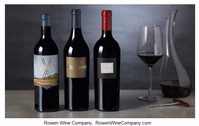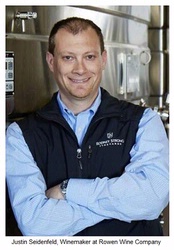|
|
 |
|
March 19, 2019
A few years back, the now-retired Rick Sayre described a novel concept for Rodney Strong Vineyards, where he presided as winemaker for more than three decades. Sayre called it a "winery within a winery."
 The winery within the winery at Rodney Strong is called Rowen. The Rowen brand utilizes a unique new source of grapes, the Cooley Ranch in northern Sonoma County. What makes the 20,000-acre property unique is the rugged terrain, with steep hillsides and peak elevations above 2,000 feet. The winery within the winery at Rodney Strong is called Rowen. The Rowen brand utilizes a unique new source of grapes, the Cooley Ranch in northern Sonoma County. What makes the 20,000-acre property unique is the rugged terrain, with steep hillsides and peak elevations above 2,000 feet.
The Rowen vineyards cover about 200 acres of the property, with plots planted at elevations between 500 and 2,040 feet. The vineyards are mostly above the fog line (the Pacific Ocean is just a few miles to the west, as the crow flies) and therefore get plenty of sun. Ryan Decker, director of Estate Vineyards at Rodney Strong, adds, "the high altitude changes the vines, they produce more leaves and more leaves give you more ripening power."
 The vineyards aren't the only unique aspect of the Rowen red blend. Winemaker Justin Seidenfeld, who succeeded Sayre, has crafted a unique blend with the 2015 vintage. With 55 percent cabernet sauvignon and 26 percent malbec, it has all the best characteristics of a classic Bordeaux-style blend. The twist is a shot of syrah (17 percent) and viognier (2 percent) that has been co-fermented, a practice that is common in France's Cote-Rotie district in the northern Rhone. The vineyards aren't the only unique aspect of the Rowen red blend. Winemaker Justin Seidenfeld, who succeeded Sayre, has crafted a unique blend with the 2015 vintage. With 55 percent cabernet sauvignon and 26 percent malbec, it has all the best characteristics of a classic Bordeaux-style blend. The twist is a shot of syrah (17 percent) and viognier (2 percent) that has been co-fermented, a practice that is common in France's Cote-Rotie district in the northern Rhone.
The result is a suave red blend that is beautifully structured and shows complex layers of red and black fruits, beautifully integrated tannins and a scintillating thread of minerality. It is a stunning wine that retails for a modest (given the ambitious nature of the project) $55. And well worth it.
The 2015 Rowen red wine is supple enough to enjoy now, yet it possesses the structure and depth to improve over 20 years in the cellar. Rowen produced 2,250 cases in 2015.
Posted by Robert Whitley at 1:58 PM
|
|
March 4, 2019
We’re now entering the scariest tax season in recent memory, with great uncertainty flowing from the 2018 “Tax Cuts and Jobs Act.” That bill will certainly affect many taxpayers, but certainly with regard to the effects on any of us individually is in very short supply. The IRS directed employers to reduce payroll withholding unbeknownst to many employees, and the revocation of the deductibility of state and local taxes will alter effective tax rates dramatically in many jurisdictions.
The situation is enough to make you want a drink…which is where I come in.
My guess is that a lot of wine lovers are looking to enjoy their favorite beverage without spending a lot of money right now, and that raises the question of how to play things wisely in the current wine market. I make no claim to financial genius, but one need not be a genius to know that the key for playing the stock market--or any market--is to run counter to its trends, selling when others are buying and buying when others are selling. That also makes sense when it comes to dealing in a cost-sensitive way with the wine market.
If you buy the wine that everyone else wants to buy, chances are that you are going to get burned--or at least not do as well as you could with a more wily strategy. To be more specific, if you bought Merlot in the mid-1990s when it was booming in the wake of the famous "French Paradox" segment on "60 Minutes," you'd likely have gotten a watery, wimpy wine. Wineries could sell anything that said "Merlot" on the label, so naturally they pushed out big crops by excessively irrigating and fertilizing their vineyards, and by rushing immature vines into production. Merlot is a potentially excellent variety, but no grape is a match for the diluting effects of a true boom in wine fashion.
Some years later, the film "Sideways" produced the double effect of pricking the Merlot bubble while inflating demand for Pinot Noir, and the lamentable results of the latter phenomenon continue to be experienced by almost anyone who tries to buy Pinot for less than $15. I taste lots of inexpensive Pinot every year, but lately it is only because I am professionally obliged to do so, and I now keep an airsickness bag next to my spit bucket.
It follows logically that the smart money looks not for wines that are booming but for ones that are undervalued at present. Which wines fit that description? Sherry is definitely one of them, and all types of Sherry are remarkably under-priced in light of the time and expense involved in making them, as well as the durability of the wines once they are opened (many hold up significantly better than table wines if refrigerated between pours, though you should really work through them within a week).
Port offers another important example. Although it is vintage ports from years like 2016 that draw the lion's share of print in the wine press, more affordable port categories are full of delicious wines at very attractive prices. Reserve ports, 10 year-old tawnies, and late bottled vintage ports are unbelievably complex and satisfying for the money, and like sherries, their power and durability makes them enjoyable far longer than most table wines.
Additionally, if you venture beyond Portugal to try other port-style wines, you can find some amazing bargains from countries like Australia. The fact that all wines in this entire category are out of fashion tilts the market in your favor, and perhaps you share my opinion that being un-fashionable is actually endearing in its own right. I love an underdog, and I hate being a lemming, so I find it very agreeable to follow the zig-when-they-zag approach.
Maybe fortified wines like sherry and port just aren't your thing, which is fine. If you want to run counter to the market while hunting for high-value table wines, you'd be wise to look for grapes, countries and regions that are relatively unknown but now on the rise. Of course, since these countries and regions are not well known, many consumers will need to do some reading to learn about them. That shouldn't be a big problem, though, since many consumers during tax season have more time and brains than money. Lots of information on developing wine regions is available free of charge, and a modest investment in a wine review resource can pay big dividends in terms of quality and savings.
Since the masses haven't gotten the word on wines like Carmenère from Chile, Jumilla from Spain, or Nero d'Avola from Sicily, producers and importers can't inflate their prices. There are plenty of other examples available from New World countries as well as Old World ones like Italy, and we profile them frequently here on WRO.
Finally, there are other wines that are no longer obscure, but that continue to offer excellent value due to special circumstances. For example, Malbec from Argentina continues to over-achieve on price, thanks to low production costs in the country and a wonderful synergy between grape and place in the dry, sunny heights of Mendoza. As a second example, Rioja is quite well known around the wine world, but its big bodegas work with great economies of scale that enable them to sell wines of impressive complexity and delicacy for $12 or less.
So…cut against the crowd if you’re in belt-tightening mode. While saving money and preparing for any possible tax season surprise, you’re also likely to learn about wines that will broaden your horizons in enduringly beneficial directions.
Posted by Michael Franz at 11:09 AM
|
|
 |
|